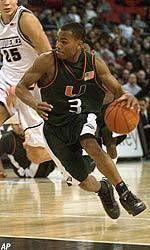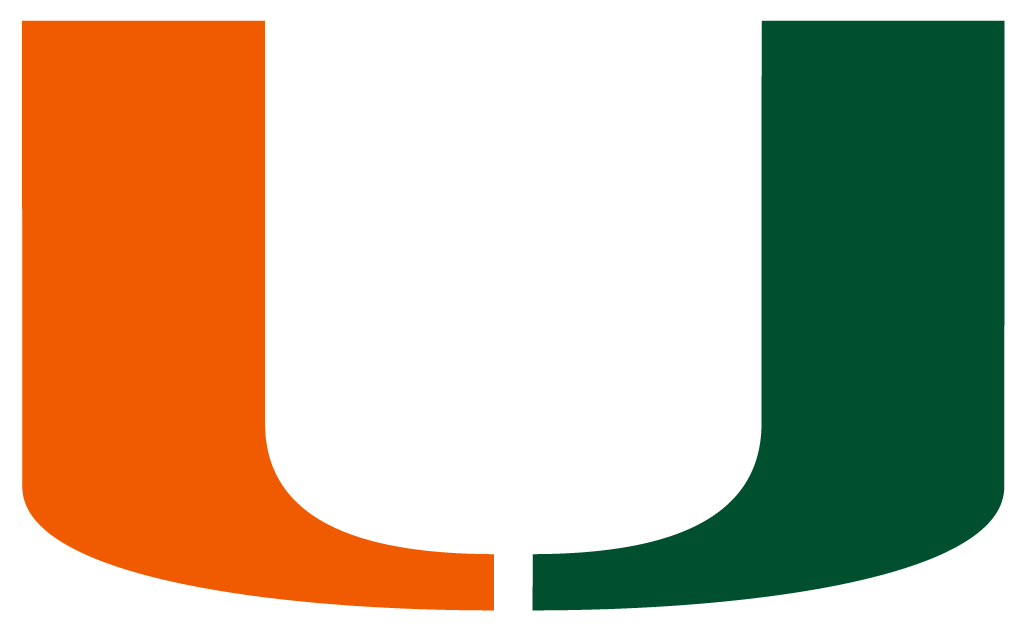
College Hoops Booming in the South
March 14, 2003
You don’t have to wait on the future of college basketball. It’s here. College basketball has fallen under a Southern reign. That and this report from The New Orleans Times-Picayune’s Jeff DuncanFrom the swamps of Louisiana to the clay hills of Georgia, the game, at all levels, has experienced a surge in popularity and interest.
Finally blessed with the resources and coaching to complement their superior athletes, Deep South teams have enjoyed unprecedented success this season:
ALABAMA: In December, the Crimson Tide was ranked No. 1 for the first time in history. It toppled from the polls after a mid-season tailspin, but it’s still a solid choice to make a second consecutive NCAA Tournament appearance.
FLORIDA: In February, the Gators were ranked No. 1 for the first time in history and have been ranked in the top 10 for most of the season. They are a lock to advance to their fifth consecutive NCAA Tournament, as many appearances as the program made in the previous 77 years combined.
GEORGIA: Before the school’s decision to suspend Coach Jim Harrick and cancel its postseason, No. 21-ranked Georgia was on track to play in its third consecutive NCAA Tournament, a first in school history. Georgia was ranked in the Top 25 since December.
LOUISIANA: The LSU Tigers upset No. 1-ranked Arizona and, thanks to a late-season rush, likely are bound for their second NCAA Tournament in the past four seasons.
MISSISSIPPI: Mississippi State likely will play in back-to-back NCAA Tournaments for only the second time. Top 10 teams Xavier and Oklahoma are among the Bulldogs’ victims this season.
This, experts say, is only the start. Many feel with the commitment finally matching the talent level, it’s only a matter of time until the Deep South becomes the same dominant force in college basketball that it is in football.
“I’ve always said once the Southern schools take basketball seriously it’s going to be very, very dangerous for big-time college basketball,” said Indiana coach Mike Davis, a Fayette, Ala., native. “If some of the football schools make a commitment to basketball it could be unbelievable. It could be scary.”
For most of its first five decades of existence, the SEC, which opens its annual postseason tournament today at the Superdome, relied on Kentucky to carry the banner in basketball. The Wildcats have won seven of the league’s eight national titles. Arkansas, an established power under former coach Nolan Richardson when the Razorbacks joined the league in 1991, won the other championship in 1994. The rest of the SEC has been shut out.
Since 1990, Deep South schools have won seven national football championships, eight baseball championships and several titles in golf, tennis and track and field. Women’s basketball teams from Alabama, Georgia and Louisiana have combined to win two titles and make 11 championship game appearances in 21 seasons. That and this report from The New Orleans Times-Picayune’s Jeff Duncan
Men’s basketball has remained largely unconquered.
In the 74 years of the NCAA Tournament, no Deep South school has won a championship. The entire region, consisting of Louisiana, Mississippi, Alabama, Georgia and Florida, has combined to make only nine Final Four appearances.
That’s about to change.
“There are so many great kids starting to come out of the region,” college basketball analyst Dick Vitale said. “It’s a domino effect. The coaching has gotten a lot better. The interest has gotten a lot better. And the commitment from the various schools has gotten a lot better.
“You’re just going to see it grow and grow. It’s still football and baseball in the eyes of the fans, but basketball people know how good the game is” (in the South).
In the past seven years, the SEC has made five Final Four appearances, including one each by Florida and Mississippi State.
“This league allows you to have that opportunity,” LSU coach John Brady said. “Fifteen or 20 years ago, you would have never thought Mississippi State could make it to the Final Four.”
It’s no longer a matter of if but when a team from Dixie cuts down the nets.
“I can envision it happening this year,” said ESPN college basketball analyst Jay Bilas, a former Duke standout.
The growth of basketball in the South can be traced to three factors: Better coaching, better resources and great talent.
The South has always been known for its athletic fertility. The region has produced its share of great basketball players. Of the NBA’s list of 50 Greatest Players, 10 played at high schools or colleges in the Deep South. Dozens more were college All-Americans or NBA All-Stars.
For coaches in the region, finding great local talent has never been a problem. Keeping it home has proved more difficult.
The region’s tepid embrace of integration in the late 1960s led many black athletes to bolt for the Northeast and Midwest. Expatriation remained common for Southern players throughout the 1970s and 1980s. Other players left to escape the shadows of football at universities that gave basketball a higher profile.
“Years ago, basketball players would go off because there wasn’t great basketball programs in their home states,” said Central Florida assistant coach Tom Schuberth, who played at Mississippi State in the mid-’70s and has recruited the South extensively during stops at Northeast Louisiana, Memphis and Alabama-Birmingham. “Now more of them are staying home because schools are making commitments to basketball.”
During a six-year period in the late 1980s and early ’90s, Mississippi produced NBA players Erick Dampier, Gerald Glass, Litterial Green, Othella Harrington, Chris Jackson (who changed his name to Mahmoud Abdul-Rauf), Antonio McDyess and James Robinson.
“I used to always say if you could ever keep all the best athletes in the state of Mississippi at one school you would win a national championship,” Schuberth said.
Instead, those seven players attended six schools.
“Just think how scary Mississippi State or Ole Miss would have been if one of them would have been able to sign Dampier, McDyess, Robinson, Ronnie Henderson and Eric Washington,” Davis said.
Still, athletic directors hardly batted an eye at lost basketball recruits as long as football was keeping their share of players home.
That attitude, along with the basketball landscape, changed in the late 1980s and early ’90s. The NBA expanded into Florida with the Orlando Magic and Miami Heat. AAU programs, funded by the deep-pocketed athletic shoe companies, took off, and the NCAA basketball tournament exploded into a national phenomenon.
In 1991, CBS signed a seven-year, $1 billion contract to televise the tournament. In 1993, the deal was extended through last season for $1.75 billion. This year, CBS begins a new contract that will pay the NCAA $6 billion to televise the tournament for the next 11 years.
At the same time, the NCAA adopted a revenue-sharing plan in which the tournament profits were distributed to conferences based upon a complicated formula involving tournament performance, participation, athletic sponsorship and academic support for athletes. Last year the share for SEC teams was about $750,000 per team, about the same as a minor bowl game.
“Money always talks,” CBS basketball analyst Billy Packer said. “The explosion of the NCAA Tournament was as significant as anything in the growth of college basketball. The emphasis at schools on getting to the NCAA Tournament was just as important as making a bowl game.”
Suddenly bottom-line-conscious athletic directors in the SEC started investing heavily into their basketball programs.
They lured top coaches with six- and seven-figure salaries. For years, Deep South coaches were known as much for their colorful personalities and off-court theatrics (See: Dale Brown, Ed Murphy, Wimp Sanderson) as their ability to script Xs and Os.
In their place came a new breed, a group of young, aggressive workaholics with a passion for recruiting and Armani clothing. Florida hired Billy Donovan in 1997. Two years later, Alabama and Mississippi State followed suit, hiring Rick Stansbury and Mark Gottfried.
“For schools to be great in a certain sport it takes resources and a willingness to hire the best coaches,” Bilas said. “The SEC has done that. They’ve made that commitment.”
Added Clark Francis of the Hoop Scoop: “Right now there are a lot of very aggressive young coaches who are great recruiters in the SEC.”
The athletic directors didn’t stop there. They poured money into facilities and doubled recruiting budgets. That and this report from The New Orleans Times-Picayune’s Jeff Duncan
Last season Florida cut the ribbon on a state-of-the-art, $11 million practice facility, a 45,000-square-foot Taj Mahoops so special the University of Kentucky sent representatives to Gainesville for a tour.
Down the coast, the University of Miami christened a $48 million basketball arena in January. The 7,000-seat University of Miami Convocation Center is replete with all the latest amenities, including luxury boxes and plush locker rooms.
Along the Panhandle, Florida State University opened a three-story, $10 million basketball training facility. The 43,000-square-foot building features two full courts with state-of-the-art shock absorbing construction below the wood panels, 8-foot doors and oak locker stalls.
“I bet back when Norm Sloan was here the basketball budget was $300,000 or $400,000,” Florida AD Jeremy Foley said. “Now it’s four or five times that, not including coaches’ salaries.”
It’s all worth the investment, Foley said, if Donovan can win the school’s first national title.
“There’s no real comparison to the sport now and 20 years ago,” Auburn athletic director David Housel said. “There’s more interest and money. More people are following the sport now. The bar raises every year in basketball.”
With the resources and coaches in place and the talent readily available, time is all that stands between the Deep South and its first national title.
Indeed, the future appears brighter than ever.
Attendance totals increased at eight of 12 SEC schools this season. The conference had a record 152 games broadcast on regional or national television. Ratings for those games increased again this season and even outdistanced the ACC in some polls.
Top 40 recruiting classes are on the way at LSU, Miami, Florida State, Mississippi State, Georgia, Florida and Alabama. And the lists of top underclass prospects are filled with players from the region.
“We made a commitment to put this program on the map,” Foley said. “And other schools have done the same thing. We are saying this is a huge priority. It’s another statement to people who think all they care about is football down there. We may lose a recruit, but it’s not going to be because they can say we didn’t have a commitment to basketball.” That and this report from The New Orleans Times-Picayune’s Jeff Duncan






